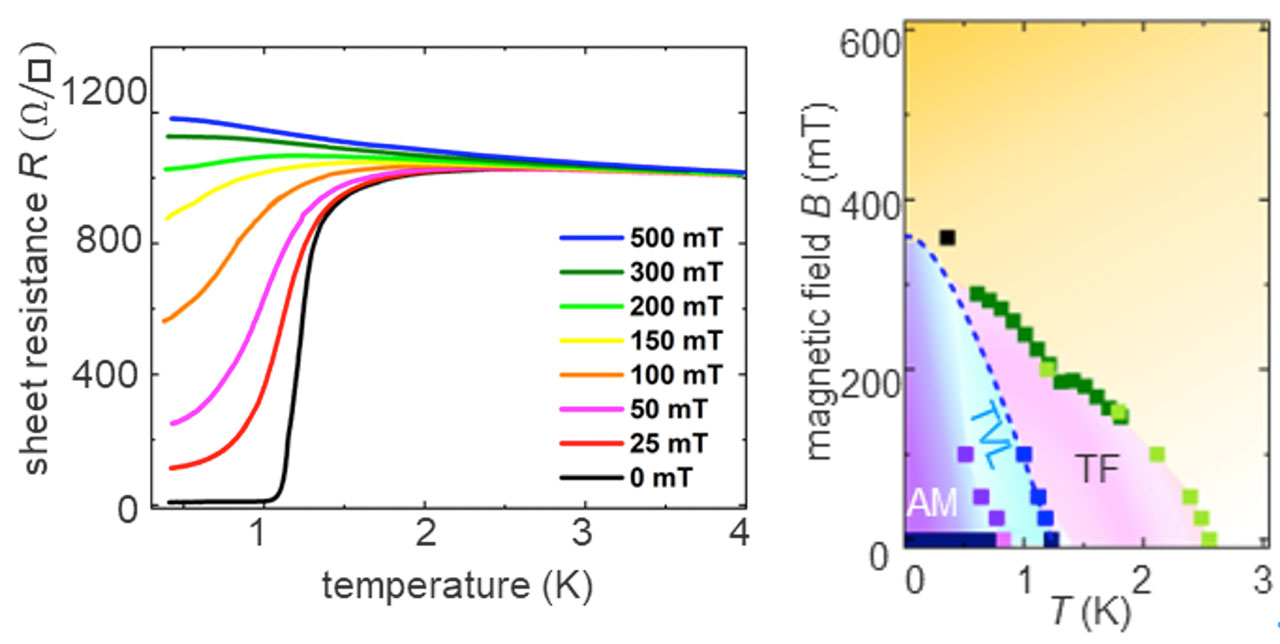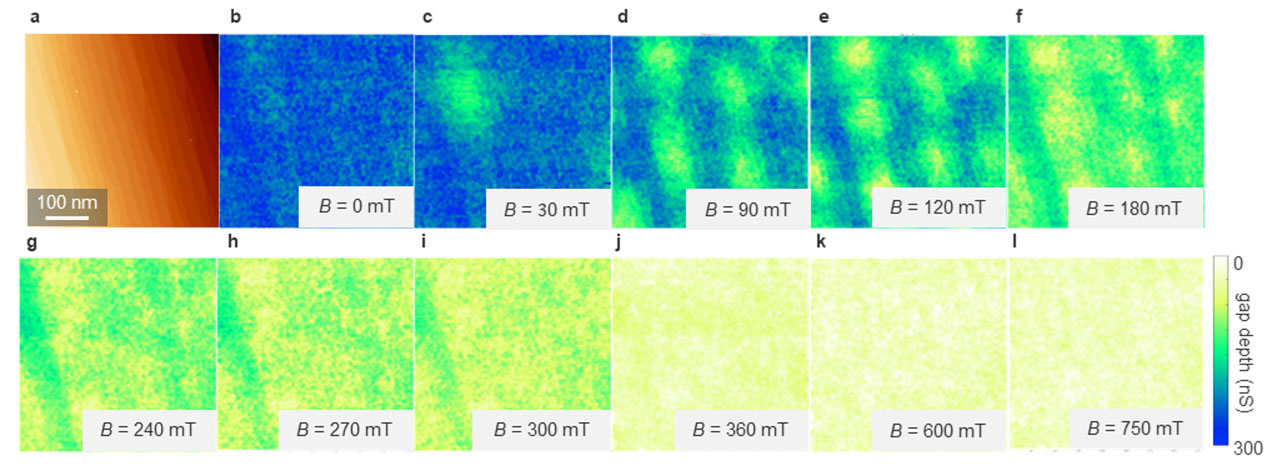Microscopic Views of Quantum Phase Transition in Disorder-Controlled 2D Superconductors
Hasegawa Group
Disorder-induced superconductor-insulator transition (SIT) in the two-dimensional (2D) systems has been a subject of extensive studies as one of typical examples of quantum phase transitions (QPT). Recent advancements in fabricating highly crystalline 2D systems revealed the unexpected quantum phases, such as anomalous metallic state and quantum Griffiths phase, around QPT. The origins of the new quantum phases are still uncovered partly because of lack of microscopic pictures. Here, by performing scanning tunnelling spectroscopy (STM) at low temperature (0.36 K) on highly-crystalline monoatomic-layer superconductors, we elucidated these quantum phases in real space microscopically.
In the present work we used one of the Pb-monolayer superconducting phases called striped incommensurate (SIC) phase formed on vicinal Si(111) substrates. On the vicinal substrates single-layer-height steps, which work as a disorder [1,2], are regularly aligned, and the density of steps can be controlled precisely with the miscut angle. We investigated how the disorder in the superconducting layers affects the presence of the quantum phases.
First we performed in situ (in ultrahigh vacuum) transport measurements on the SIC phases formed on 1.1°-tilted vicinal substrates (Fig. 1). The terrace spacing for the vicinal substrate is 16 nm, shorter than the coherence length of the system (38 nm). The superconducting critical temperatures Tc of the vicinal samples are 1.21 K, slightly lower than the flat sample (1.53 K). Under out-of-plane magnetic fields below the critical field Bc2, the sample exhibits non-zero resistance near zero temperature, indicating the presence of anomalous (quantum) metallic phase, which is often explained with the quantum motion of vortices. From the Arrhenius plots of the sheet resistance R, we determined the crossover temperature between the regions where the quantum and thermal vortex motions are dominant.

Fig. 1. (left) Temperature dependence of sheet resistance R measured on the 1.1°-tilted vicinal sample under out-of-plane magnetic fields of 0, 25, 50, 100, 150, 200, 300 and 500 mT. (right) B-T phase diagram obtained from the data shown in the left panel. AM: anomalous metallic phase, TVL: thermal vortex liquid phase, TF: thermal-fluctuation-induced metallic phase..
Outside of the superconducting regime, metallic phases (dR/dT > 0) are observed. Whereas the thermal-fluctuation-induced metallic (paraconductivity) phases are found above Tc, the quantum-fluctuation (QF)-induced metallic phase, which appears above Bc2 near T = 0, appears only on the flat sample, was not observed on the vicinal sample. The absence of the QF-induced metallic phase on the step-abundant sample is consistent with the fact that the QF-induced metallic phase, which is often attributed to quantum Griffith phase, is only observed on highly-crystalline monolayer samples.
Then, we performed STM observation at low temperature (T = 0.36 K). Figure 2 shows the results taken on the vicinal sample. Figure 2(a) is an STM image showing equally-spaced steps on the surface. Figure 2(b)-2(l) are maps showing the spatial distribution of the superconducting gap under various out-of-plane magnetic fields B. At B = 120 mT, individual oval vortices elongated along the steps are observed. The oval shape is due to the Josephson coupling at the steps and explained as Josephson-Abrikosov vortices [2]. By increasing B to 180 mT, vortices are significantly overlapped each other but still individual vortices are recognized, but at B = 270 mT individual vortices are not observable any more. Bc2can be estimated from the gap evolution with B outside of the vortices and found Bc2 = 355 mT, which is consistent with that obtained by the transport measurement (Black square in the phase diagram of Fig. 1 corresponds to the Bc2 by STM.). In the range of 270 mT < B < Bc2, the density of vortices should increase with B and in fact averaged gap depth decreases, but individual vortices cannot be seen. The indistinct vortices are, therefore, due to liquidation of vortices. Above Bc2, we still observed the gap remaining, and the pseudo gap disappears around B = 500 mT.
According to the phase diagram obtained by the transport measurement (right panel of Fig. 1), under 30 mT < B < 120 mT finite resistance is observed and thus anomalous metallic phase should be there at T = 0.36 K. However, in STM, we observed individual vortices, indicating the presence of short-range order of the vortex arrangement, at least. The regime is, therefore, the quantum creep phase, and the finite resistance is likely generated due to the vortex motions induced by infinitesimal current for the transport measurement.
We performed the same measurements on the flat sample and basically the same results were obtained in the low B range. Curiously, however, the vortex liquid phase was not observed on the flat sample. The vortex liquidation, which we believe induced by the quantum fluctuation, occurs only under the presence of phase fluctuation induced by the disorder.
Under B higher then Bc2, we observed a pseudo gap on both flat and vicinal samples. This implies that the localized Cooper pairs are formed, presumably by quantum fluctuation, regardless of the degree of disorder. Depending on the degree of disorder, however, the amount of the localization is different, making the system metallic or insulating depending on the amount of disorder.
References
- [1] S. Yoshizawa et al., Phys. Rev. Lett. 113, 247004 (2014).
- [2] Y. Sato et al., Phys. Rev. Lett 130, 106002 (2023).

